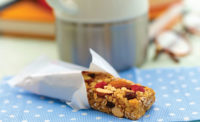The Breakfast Club
By Deborah Cassell
For many Americans, breakfast is not to be missed. Whether it’s sugar cereal, whole grain toast, on-the-go bars or fatty fast foods consumers crave, the a.m. hours remain a relevant source of fuel to turbocharge the day.
The most important meal of the day has become the highest-calorie meal of the day for many consumers, especially those swinging by the drive-thru for one of those fast food breakfast sandwiches that are sweeping the country. For others, weekday breakfasts consist of nothing more than a cereal bar and a cup of coffee … if that. Regardless of what poison (or lack thereof) the consumer picks, there are an increasing number and variety of healthy and unhealthy options for everyone, from the on-the-go eater to the sit-down breakfasteer.
Toastmasters
In a recent survey of 2,088 consumers (“What America Eats,” 2005), Parade magazine learned that 67% of respondents eat cereal (59% cold and 31% hot) on weekdays. Although cereal can be a good source of whole grains, especially given all the new varieties on the market, it’s not the only, or best, source. Thankfully, many Americans continue to raise their juice glasses in honor of one big breakfast staple: toast. Parade’s survey found that 38% of Americans eat toast on weekdays, 41% eat toast on Saturdays and 43% eat toast on Sundays. According to the Grain Foods Foundation, more than 75 million Americans enjoy a piece of toast every day.
Whether it’s white, wheat or rye one wants, there is an array of breads from which to choose. However, increased emphasis on whole wheat and whole grain breads are making a major impact on the bread — and English muffin and bagel — category. (When Wonder Bread launches a whole grain version of its soft bread classic, you know something’s up.)
Sara Lee recently introduced three whole grain breakfast breads— brown sugar with cinnamon, cinnamon with raisins and blueberry crumble — that use between 35% and 45% whole grain flour and contain either 3 gm. or 4 gm. of fiber per serving, making them a good source of fiber by U.S. Food and Drug Administration standards.
English muffin enthusiasts now can get their grains with Sara Lee’s new Original English Muffins Made with Whole Grain, which are made with 14% whole grain flour and offer 5 gm. of whole grain per muffin, or Sara Lee’s Heart Healthy Wheat English Muffins Made with Honey, which are 30% whole grain and contain 10 gm. of whole grain per muffin. Each variety offers 2 gm. of fiber per serving.
For bagel buffs with a penchant for whole wheat, Lender’s has unveiled its New York Style Bagels in five varieties: 100% Whole Wheat, Whole Grain-Multi Grain, Whole Grain Plain, Whole Grain Cinnamon Raisin and Everything. According to James D’Agosta, category director of Lender’s, the New York Style Bagels came about as “a direct response to consumers’ demands to maintain a healthy diet.”
|
Location, Location, Location Where do you usually eat breakfast? | ||||
Weekdays | Saturday | Sunday | ||
| At home | 72% | 87% | 87% | |
| On the way to work | 15% | 2% | 1% | |
| Fast food restaurant | 8% | 9% | 5% | |
| Coffee shop chain (e.g. Starbucks) | 2% | 2% | 2% | |
| Local coffee shop/diner/restaurant/deli | 5% | 11% | 11% | |
| At work, bought from cafeteria | 5% | 1% | * | |
| At work, brought from home | 16% | 2% | 1% | |
| At work, from local deli, coffee shop | 5% | 1% | 1% | |
| Other | 3% | 2% | 2% | |
| *Less than 1% SOURCE: What America Eats-X Survey (2005), Parade magazine | ||||
As the whole grain craze picks up speed, no doubt other bagel, English muffin and bread bakers will join up. In fact, Weston Bakeries has added whole grains to a number of its Thomas’, Arnold and Brownberry products.
On-The-Go Gang
For the 15% of Americans who eat breakfast en route to work (according to the Parade survey), on-the-go cereal bars/breakfast bars are of utmost convenience.
For example, Quaker’s new low-fat Oatmeal to Go bars offer one serving of whole grain Quaker oats, 4 gm. of protein and 5 gm. of fiber, including 1 gm. of soluble fiber. Quaker Breakfast Cookies are another option. Available in two varieties — oatmeal raisin and apple cinnamon — each soft and chewy cookie is made with whole grain Quaker oats and provides 5 gm. of dietary fiber.
According to “The Future of Eating Meals On-The-Go,” a study done by Datamonitor, “cereal bars have successfully moved beyond the breakfast meal slot to become not only an on-the-go direct replacement for breakfast cereals, but also a daytime snack or an integral component of an at-home breakfast.” The report also predicts that the cereal bar market will continue to grow as new products are introduced to the segment.
Fast Food Factions
McDonald’s has long dominated the fast food breakfast scene with its buttery Egg McMuffins, sausage biscuits and hand-held hash browns. Last year, Burger King expanded its options, too, in a big way. Who can forget the Enormous Omelet Sandwich — one sausage patty, two eggs, two American cheese slices and three strips of bacon, for a whopping 730 calories and 47 gm. of fat? (Does that come with a coupon for a free cardiogram?)
Now, chains such as Chick-fil-A, Subway, Carl’s Jr. and Wendy’s (which recently announced plans to test-market breakfast items this spring) are jumping on the bandwagon by expanding their offerings. For instance, Hardee’s new morning menu includes the Steak ‘N’ Egg Burrito, featuring strips of real grilled steak, a blend of Swiss and Cheddar cheeses, and two eggs, all wrapped in a warm flour tortilla and served with salsa.
Dunkin’ Donuts also added to its line of breakfast sandwiches. The new Supreme Omelet sandwich combines crisp bacon and melted American cheese on top of scrambled eggs stuffed with diced green and red peppers, scallions, hash brown potatoes, and Swiss and Monterey Jack cheeses, and is served on a warm, freshly baked croissant.
Even convenience stores are edging in on a.m. foodservice. ExxonMobile recently rolled out a line of proprietary gourmet breakfast sandwiches at its 680-plus On the Run C-stores. It features five sandwiches: Sausage, Egg and Cheese Biscuit; Ham, Egg and Cheese Croissant; Bacon, Egg and Cheese English Muffin; Sausage, Egg and Cheese Bagel; and Sausage Biscuit. Meanwhile, 7-Eleven offers breakfast taquitos.
Loyal Starbucks supporters now are privy to hot breakfast sandwiches, as well. The coffee maven’s new menu includes an egg on English muffin with bacon, spinach or sausage for $3.
The options are endless for a.m. eaters. An ever-changing marketplace brings forth new breads, bars, cereals and sandwiches every day, in an effort to encourage new members to join the breakfast club. SF&WB
Healthy Choices?
According to Parade magazine’s 2005 “What America Eats” survey, about 78% of respondents consider fruit to be a healthy breakfast choice, followed by oatmeal at 77%, cereal at 74% and eggs at 66%.
Breaking the Rules
Forget cold leftover pizza for breakfast. How about hot pizza engineered specifically for a.m. eaters? Both Papa John’s and regional chain Happy Joe’s have started offering omelet pizzas at limited locations. Could a Chicago-style, deep-dish breakfast pizza be next? Check out the freezer case!
Playing Hooky
Although breakfast is not the most commonly missed meal of the day, it may well be on its way to claiming that title. The propensity to skip breakfast is largely determined by age, according to a 2005 Datamonitor report (“The Future of Eating Meals on the Go”). For instance, children regularly consume breakfast into their early teenage years, under parental influence. However, social pressures and body image concerns cause teenage consumption of breakfast to wane. Datamonitor reports that among all groups, consumers between the ages of 18 and 34 are most likely to skip breakfast, citing “lack of time” as the reason. Consumers over the age of 65 are least likely to miss the meal.
Solving the No. 1 Problem For Foodservice Operators
Lack of skilled labor remains a challenge for both supermarket delis and foodservice restaurants. Wages and benefits typically account for one-third of sales, while food, beverage and occupancy costs account for another 40%, according to the National Restaurant Association.
Although many foodservice chains are large, average unit sales in 2002 (the latest figures available) were $730,000 at full-service restaurants and $619,000 at QSRs. More than seven out of 10 still are managed by single independent operators.
Bakers and snack suppliers need to work with foodservice operators to provide convenient, versatile products that decrease labor needs and can be used in a variety of menu applications, notes B. Hudson Riehle, senior vice president of the NRA’s research and information services division.
“Being able to use one product in a myriad of [menu items] is important,” he says. “Herald the product’s diversity.”
In addition to menu differentiation, providing a simple cost/benefit analysis and highlighting the product’s margin and health appeal will open more doors. McDonald’s, for instance, tested a deli program, but decided not to roll it out because logistics, labor and cost per unit were prohibitively expensive. The risk/reward ratio of the deli program couldn’t be justified. Instead, the nation’s largest QSR chain introduced a Premium Chicken Sandwich on a honey wheat roll. That menu expansion was hugely successful at a fraction of the cost of the deli program, according to industry sources.
In addition, Riehle says, bakers and other suppliers who provide marketing support such as consumer research and merchandising tools, including table-tents, posters and innovative recipes, will have an inside track.
“Get the chef involved in the promotion of the product,” he says.
Retailers Refine Their Takeout Menu
The continued emergence of new restaurant chains and the menu diversification in established ones is good news for bakers, snack producers and consumers who pay the bills. Although 76% of meals are prepared at home, four out of five adults agree that they have a larger selection of restaurants available to them than they did two years ago, the National Restaurant Association (NRA) reports.
Foodservice sales remain around 47% of all dollars spent on food, according to the NRA. It’s ironic, but many pundits predicted more than a decade ago that foodservice would easily pass over retail food sales in the near future, but that hasn’t happened.
What’s going on here?
“Foodservice growth slowed during the last three years, and retail sales held its own,” explains Jerry Smiley, founder of Strategic Growth Partners Inc. in Roselle, Ill. “That played a role. However, foodservice is back to strong growth.”
At the same time, supermarkets, convenience stores and other retailers are competing more effectively for foodservice dollars, especially as of late. Midwestern convenience-store chain White Hen, for instance, has added hot sandwich items to its lunch menu. A bright red neon sign, similar to that of Krispy Kreme Doughnuts, promotes White Hen’s deli and sandwich offerings.
Likewise, Whole Foods not only offers sandwiches and soups, but also full entrees, a sushi station, hot pizza and an assemble-your-own stir-fry.
Remember “meal replacement,” the hot catchphrase of the 1990s? Remember the coagulating, unappetizing-looking stuffed peppers, Salisbury steak and other icky entrees packaged in clear containers that sat in display cases too long and appeared as if they had been upchucked by a dog?
It’s different now.
Today’s supermarket delis, especially in new or remodeled stores with ample seating, are learning from their past mistakes by preparing fresh foods, often in an open-kitchen environment. Smiley suggests that many chains aren’t there yet, but they’re getting close.


